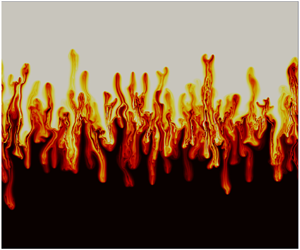Published online by Cambridge University Press: 03 April 2020

The interface between two miscible solutions in porous media and Hele-Shaw cells (two glass plates separated by a thin gap) in a gravity field can destabilise due to buoyancy-driven and double-diffusive effects. In this paper the conditions for instability to arise are presented within an analytical framework by considering the eigenvalue problem based on the tools used extensively by Chandrasekhar. The model considered here is Darcy’s law coupled to evolution equations for the concentrations of different solutes. We have shown that, when there is an interval in the spatial domain where the first derivative of the base-state density profile is negative, the flows are unstable to stationary or oscillatory modes. Whereas for base-state density profiles that are strictly monotonically increasing downwards such that the first derivative of the base-state density profile is positive throughout the domain (for instance, when a lighter solution containing a species A overlies a denser solution containing another species B), a necessary and sufficient condition for instability is the presence of a point on either side of the initial interface where the second derivative of the base-state density profile is zero such that it changes sign. In such regimes the instability arises as non-oscillatory modes (real eigenvalues). The neutral stability curve, which delimits the stable from the unstable regime, that follows from the discussion presented here along with the other results are in agreement with earlier observations made using numerical computations. The analytical approach adopted in this work could be extended to other instabilities arising in porous media.